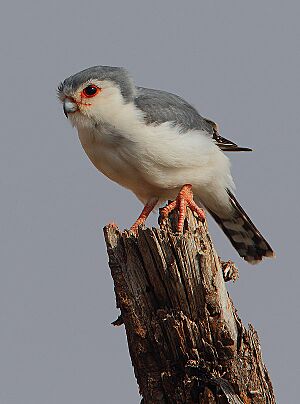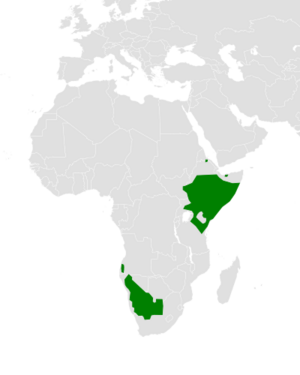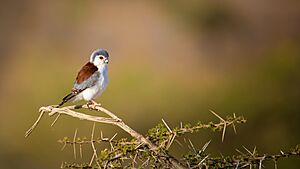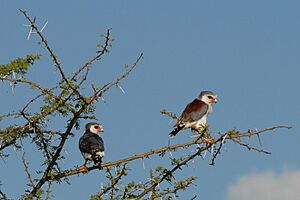Pygmy falcon facts for kids
Quick facts for kids Pygmy falcon |
|
|---|---|
 |
|
| Male in Buffalo Springs National Park, Kenya | |
| Conservation status | |
| Scientific classification | |
| Genus: |
Polihierax
|
| Species: |
semitorquatus
|
 |
|
The African pygmy falcon (also called the pygmy falcon) is a tiny raptor. It lives in eastern and southern Africa. This amazing bird is the only species in its group, called Polihierax. It's the smallest bird of prey in Africa! In fact, it's one of the smallest raptors on Earth. Only some Asian falconets are even smaller.
Contents
What Does the Pygmy Falcon Look Like?

Adult pygmy falcons are about 20 cm (7.9 in) long. They weigh between 54 to 76 g (1.9–2.7 oz).
These birds have white bellies and faces. Male falcons have grey backs. Females have a reddish-brown back. They have white "eye spots" on the back of their neck. Young falcons have brown backs, which are not as bright as adult females. Their chest might have a reddish tint.
The feathers on their wings are spotted black and white. The tail has black and white stripes. They fly low to the ground in a wavy pattern. Pygmy falcons look a bit like some shrike birds because of their small size and similar colors.
Their call sounds like a high-pitched kikiKIK. In southern Africa, it can sound like a 'chip-chip' or 'kik-kik-kik-kik'.
Where Do Pygmy Falcons Live?
Pygmy falcons live in dry bush areas. One type, P. s. castanonotus, lives from South Sudan to Somalia. It also lives south to Uganda and Tanzania. Another type, P. s. semitorquatus, lives from Angola to northern South Africa.
Their home range is huge, covering about 2.7 million square kilometers. Scientists believe there are at least 100,000 pygmy falcons. There might even be up to one million of them!
How Pygmy Falcons Live
Pygmy falcons are very good at dealing with changes in their environment. This includes changes from weather patterns like El Niño. They can control their body temperature well. They often use the nests of sociable weaver birds for shelter. They also roost together in groups. This helps them save energy when they are resting.
What Do Pygmy Falcons Eat?
Pygmy falcons mostly eat reptiles and insects. Sometimes, they will eat small birds or rodents. They might also eat small mammals that are the right size. They hunt by sitting on a high branch. Then, they swoop down and catch their prey.
Some animals try to be smart to avoid the falcons. For example, Kalahari tree skinks seem to listen to nearby sociable weaver birds. The weavers make loud warning calls when danger is near. This gives the skinks time to hide.
Reproduction and Nests

In Kenya, pygmy falcons build their nests inside the nests of white-headed buffalo weaver birds. The areas where these two birds live often overlap. In southern Africa, pygmy falcons are found near red-billed buffalo weaver nests. But they mostly use empty rooms in the large, multi-room nests of sociable weavers. They do this even if the sociable weavers are still living in other parts of the nest.
Even though pygmy falcons eat birds and are bigger than sociable weavers, they usually leave the weavers alone. However, they do sometimes catch and eat young or even adult weavers.
Falcons need to use these weaver nests. This means they get all the benefits of a safe nest without having to build or fix it. Weavers also don't keep up the parts of the nest that the falcons use. This can make those parts more likely to break off. Falcons seem to prefer nest rooms that are away from the center of the weaver colony. They also like rooms with shorter entrance tunnels. Falcons are bigger than weavers, so longer tunnels might be hard for them to get through.
Pygmy falcons mark their nests with their droppings. Scientists are not sure why they do this. It might scare away snakes. It could also reduce tiny bugs that live on them. The droppings might also help the baby falcons' immune systems. Or, it could be a signal to other falcons that the nest is taken.
Breeding happens between August and February. The busiest time is in September and December. Most often, they lay three eggs. These falcons usually breed once, or up to three times, in a season.
Living Together and Helping Out
Sometimes, more than two adult pygmy falcons live together in a territory. They might all help take care of the young birds. There are a few ideas why they do this:
- Defense: More adults can help protect the nest.
- Sharing duties: More adults can help with raising the young.
- Helping young stay safe: Young falcons might stay with their parents longer to help.
- Warmth: More birds together can help keep each other warm. In winter, African pygmy falcons nest deeper inside sociable weaver nests. This gives them better insulation and warmth.
How Are Pygmy Falcons Doing?
Pygmy falcons are not considered to be in danger. Their population is stable.


